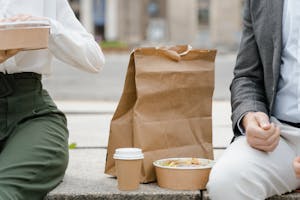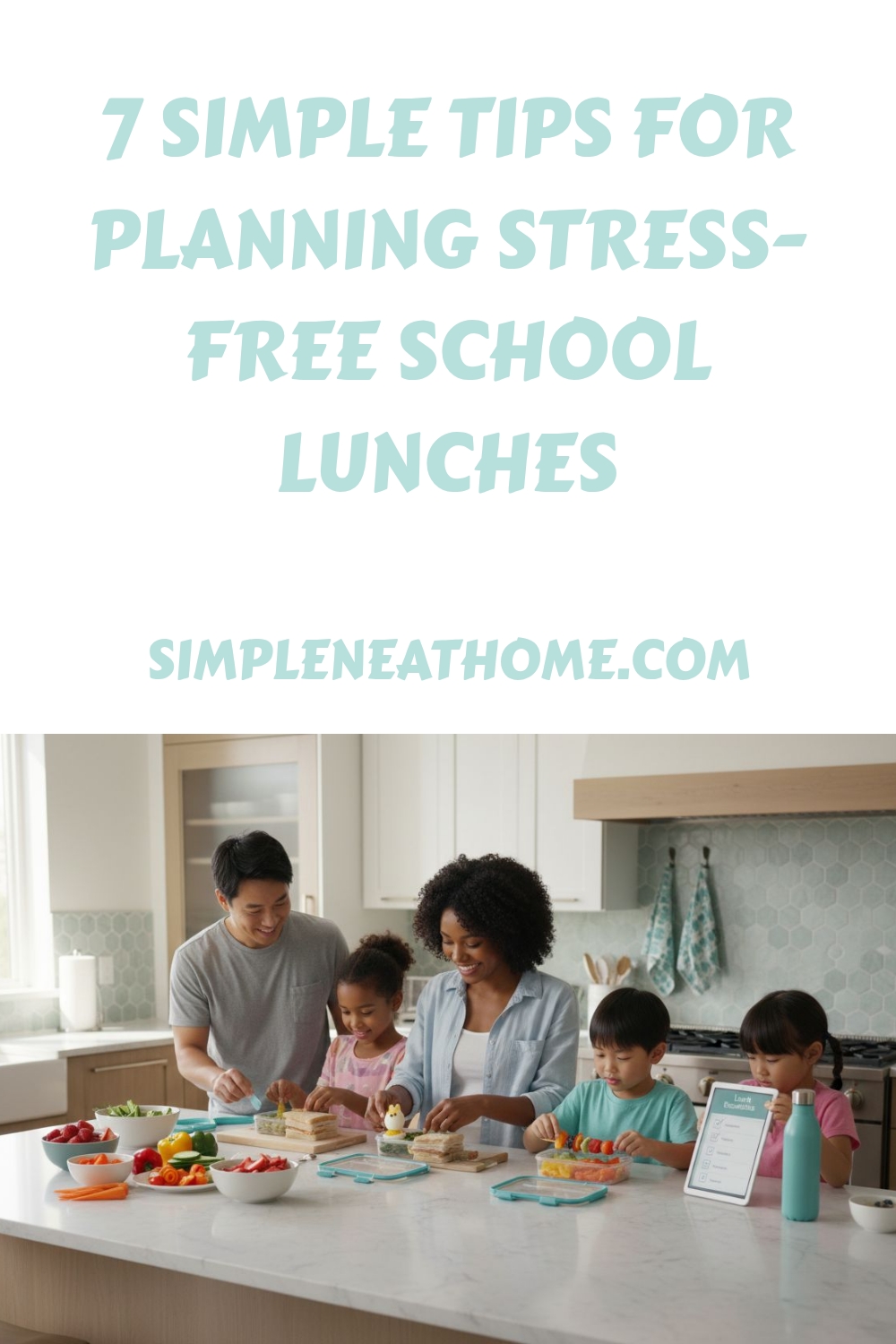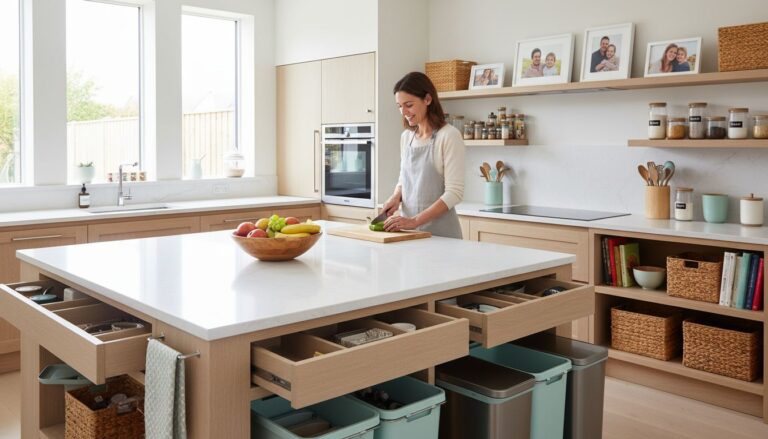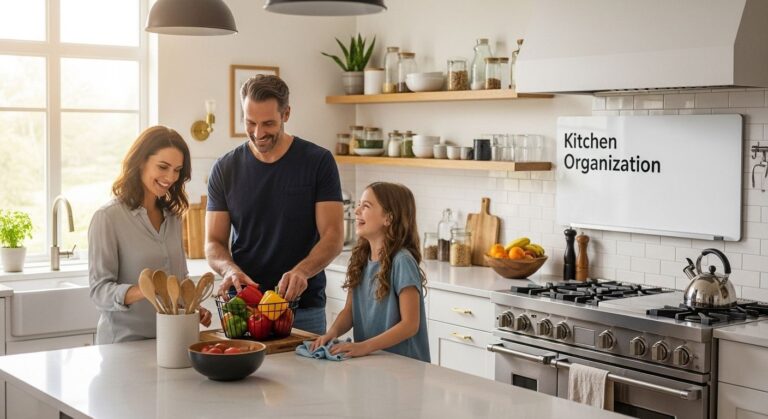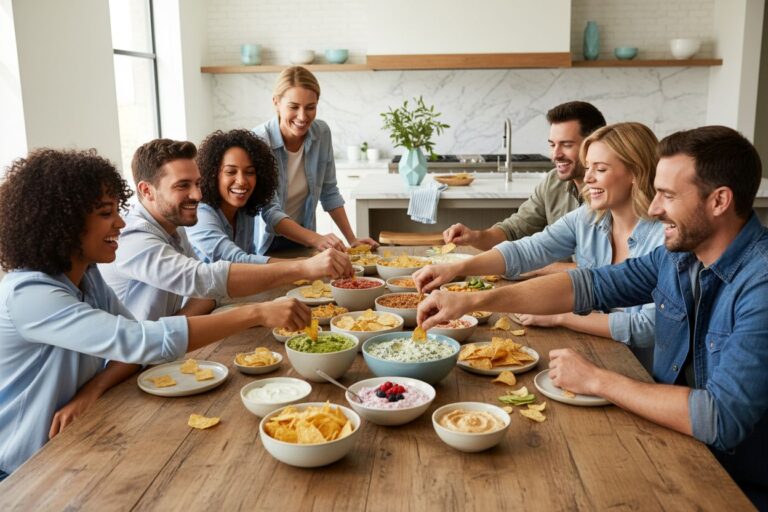7 Simple Tips for Planning Stress-Free School Lunches
Did you know that families spend an average of over 40 hours per school year just packing lunches? With so many mornings lost to searching for missing snacks or last-minute meal ideas, school lunch prep can quickly become a source of daily stress. Getting organized means more time together and healthier meals for your kids. Practical tips can help you reclaim those mornings, save money, and keep lunches interesting all year long.
Table of Contents
- 1. Plan Lunches For The Whole Week Ahead
- 2. Create A Balanced Lunch With All Food Groups
- 3. Prep Ingredients The Night Before
- 4. Use Reusable Containers To Stay Organized
- 5. Get Kids Involved In Lunch Planning
- 6. Incorporate Easy Make-Ahead Recipes
- 7. Keep A Lunch Essentials Checklist Handy
Quick Summary
| Takeaway | Explanation |
|---|---|
| 1. Plan lunches weekly | Dedicate 30 minutes on Sunday to prepare lunches for the week, reducing morning chaos and ensuring balanced nutrition. |
| 2. Build balanced meals | Use the Kid’s Healthy Eating Plate model to ensure each lunch includes fruits, vegetables, grains, proteins, and fats. |
| 3. Prep ingredients nightly | Spend 15-20 minutes each evening organizing lunch components to streamline morning routines and minimize stress. |
| 4. Use reusable containers | Choose bento-style containers to keep food organized and fresh, promoting portion control and reducing waste. |
| 5. Involve kids in planning | Encourage children to participate in selecting lunch items, increasing the likelihood they will enjoy what they eat. |
1. Plan Lunches for the Whole Week Ahead
Stress less and save time by mapping out your school lunches before the week begins. Weekly lunch planning transforms chaotic mornings into smooth sailing and helps you create nutritious meals your kids will actually enjoy.
According to American Heart Association, packing lunches means you control exactly what nutritious foods your children eat. By dedicating just 30 minutes on Sunday to lunch prep, you can create a roadmap that keeps everyone happy and healthy.
Why Weekly Planning Matters:
- Reduces morning stress
- Ensures balanced nutrition
- Saves money on impulse lunch purchases
- Teaches kids about meal planning
Using the MyPlate guide, aim to incorporate all five major food groups: fruits, vegetables, dairy, grains, and protein. This approach guarantees your child receives a well-rounded meal that supports their growth and energy levels.
Start by creating a simple spreadsheet or using a magnetic whiteboard in your kitchen. List out each day and sketch basic lunch ideas that include protein, a complex carbohydrate, fruits, and vegetables. Pro tip: Involve your kids in the planning process so they feel excited about their upcoming meals.
Remember that variety keeps lunch interesting. Rotate between different sandwich styles, wrap options, and protein sources to prevent lunch fatigue. Batch cooking proteins like grilled chicken or hard boiled eggs can make weekday preparation lightning fast.
With a solid weekly plan, you will transform lunch preparation from a daily headache into an organized, stress free routine that nourishes your family and saves precious morning minutes.
2. Create a Balanced Lunch with All Food Groups
Building a nutritious school lunch is like creating an edible puzzle where every piece matters. Your goal is simple: pack a meal that gives your child the energy and nutrients they need to learn and play all day.
According to the Harvard School of Public Health, the Kid’s Healthy Eating Plate offers an amazing blueprint for lunch construction. Think of your child’s plate as divided into strategic sections that work together to fuel their day.
Balanced Lunch Breakdown:
- Half plate: Fruits and vegetables
- Quarter plate: Whole grains
- Quarter plate: Healthy proteins
- Small side: Healthy fats
- Optional: Dairy serving
Research from Harvard Health suggests a nutritious lunch should include specific serving sizes. This means one serving each of fruit, vegetables, grains, protein, and dairy.
To make this practical, start with colorful fruits and vegetables. Slice up some cucumber sticks, add cherry tomatoes, or pack apple slices. Whole grain options like whole wheat bread, brown rice, or quinoa provide lasting energy. Choose lean proteins such as grilled chicken, turkey, beans, or hard boiled eggs.
For younger kids, make nutrition fun. Cut sandwiches into fun shapes, create veggie faces on their plates, or use colorful containers that make healthy eating feel like an adventure. Get them involved in lunch planning so they feel excited about their meals.
Remember that variety keeps nutrition interesting. Rotate your ingredients weekly to prevent lunch boredom and ensure your child receives a wide range of essential nutrients. By thinking of lunch as a balanced mission rather than a chore, you will set your child up for success.
3. Prep Ingredients the Night Before
Turning morning chaos into smooth sailing starts with a little evening preparation. By prepping lunch ingredients the night before, you can transform your morning routine from frantic to fantastic.
According to Community Public Health experts, cutting up fruits and vegetables in advance makes them more appealing and easier for children to eat during lunch. This simple step encourages healthier eating habits while saving precious morning minutes.
Nighttime Prep Strategies:
- Wash and chop produce
- Pre portion proteins
- Organize containers
- Set out nonperishable items
- Chill ingredients appropriately
Harvard Health recommends preparing lunch components the evening before to ensure a balanced meal is ready to go. Think of this as setting up a lunch assembly line that future you will appreciate.
Start by selecting clean storage containers and washing all produce. Slice cucumbers, chop carrots, and segment oranges. Pre cook proteins like grilled chicken or hard boiled eggs. Measure out nuts, seeds, or granola for easy grab and pack moments.
For maximum efficiency, check out our quick meals guide for additional time saving tips. Pro tip: Keep a designated lunch prep area in your refrigerator with all prepped ingredients grouped together.
By investing 15 to 20 minutes each evening in lunch preparation, you will create a streamlined morning routine that reduces stress and ensures your children start their day with a nutritious meal. The key is consistency and making prep feel like a simple, enjoyable ritual rather than a tedious chore.
4. Use Reusable Containers to Stay Organized
Reusable containers are your secret weapon in creating stress free school lunches that look great and keep food fresh. Think of them as your lunch preparation superheroes, ready to save you time and reduce waste.
According to the Harvard Nutrition Source, bento style containers with multiple compartments are game changers. These clever containers help with portion control, keep different foods separate, and encourage a variety of meal options.
Container Selection Strategies:
- Choose leak proof designs
- Select multiple compartment options
- Pick size appropriate for age
- Consider insulated models
- Look for easy clean materials
Harvard Health recommends using insulated lunch boxes that maintain food temperature, which is crucial for food safety and meal quality. An insulated container can keep cold foods chilled and warm foods heated until lunchtime.
When selecting containers, prioritize durability and functionality. Look for BPA free plastic, stainless steel, or glass options that are lightweight and easy for kids to open. Transparent containers can help children see their meal options, making lunch more exciting.
For comprehensive kitchen organization tips, explore our kitchen organization essentials guide. Pro tip: Invest in a set of containers with matching lids to reduce morning confusion and streamline your lunch packing process.
By investing in quality reusable containers, you will not only simplify your lunch preparation routine but also teach your children valuable lessons about organization, sustainability, and healthy eating habits.
5. Get Kids Involved in Lunch Planning
Turning lunch preparation from a chore into a fun family activity can transform your morning routine. When children become active participants in meal planning, magic happens.
Harvard Health reveals a powerful insight: involving children in lunch decisions dramatically increases the likelihood they will actually eat what you pack. This means less food waste and happier kids.
Engagement Strategies:
- Create a weekly lunch menu together
- Let them pick foods from each food group
- Design a fun selection chart
- Give age appropriate tasks
- Praise their decision making
According to research from Texas A&M University, allowing children to select foods across different food groups empowers them to build balanced meals. This approach teaches nutrition while giving kids a sense of control.
Start with simple choices. For younger children, offer two healthy options within each food group. Older kids can help with more complex meal planning. Create a colorful chart where they can check off items they want to include in their lunch.
Make it a weekend ritual. Sit down together and discuss lunch ideas. Show them how to balance proteins, vegetables, fruits, and grains. Turn it into a game where they earn points for creating nutritionally diverse meals.
Remember that involvement looks different at every age. A six year old might help wash vegetables, while a twelve year old could partially prepare their own lunch. The goal is gradual skill building and nutritional education.
By transforming lunch planning into a collaborative adventure, you will not only simplify your morning routine but also help your children develop lifelong healthy eating habits.
6. Incorporate Easy Make-Ahead Recipes
Make ahead meals are your secret weapon in conquering school lunch stress. By preparing delicious recipes in advance, you transform chaotic mornings into smooth sailing lunch experiences.
American Heart Association recommends using dinner leftovers strategically for next day lunches. Soups, chili, and grilled chicken are perfect options that reheat beautifully and provide nutritious midday meals.
Make Ahead Recipe Strategies:
- Prepare meals during weekend
- Choose recipes with long refrigerator life
- Select protein rich options
- Use colorful ingredients
- Plan for easy reheating
Harvard Health suggests creating recipes like pasta salad with multi color noodles and adding hard boiled eggs or beans for balanced nutrition. These meals can be prepared days in advance and stay fresh in the refrigerator.
For maximum efficiency, explore our no chop recipes guide that minimizes meal preparation time. Consider recipes that taste great cold or can be easily reheated like quinoa bowls, Mediterranean pasta salads, or bean and rice mixtures.
Try batch cooking on Sunday afternoons. Prepare multiple lunch portions simultaneously using similar ingredients to reduce overall preparation time. Store meals in clear containers with labels indicating preparation date to keep track of freshness.
Remember that variety prevents lunch boredom. Rotate your make ahead recipes weekly and involve your kids in selecting interesting flavor combinations. By planning ahead, you will create nutritious lunches that make both parents and children happy.
7. Keep a Lunch Essentials Checklist Handy
A lunch essentials checklist transforms chaotic meal preparation into a smooth, stress free process. Think of it as your personal lunch planning roadmap that ensures nothing gets forgotten.
Harvard Health recommends a balanced lunch that includes specific serving sizes: one serving of fruit, one serving of vegetable, two servings of grains, one serving of protein, and one serving of dairy.
Lunch Checklist Components:
- Protein source
- Whole grain option
- Fresh fruits
- Fresh vegetables
- Dairy or dairy alternative
- Reusable water bottle
- Utensils
The Harvard Nutrition Source suggests following the Kid’s Healthy Eating Plate model: half the plate with fruits and vegetables, quarter with whole grains, and quarter with healthy proteins. For maximum efficiency, check out our pantry organization guide to streamline your ingredient selection.
Create a physical or digital checklist you can quickly reference each morning. Laminate a paper version or save a digital template on your phone. Color code or use checkboxes to make tracking fun and visually engaging.
Pro tip: Take a photo of a perfectly packed lunch to use as your template. This visual guide helps children learn what a balanced meal looks like and makes future packing easier. Update your checklist seasonally to keep meals interesting and nutritionally diverse.
By maintaining a consistent lunch essentials checklist, you will transform meal preparation from a stressful chore into a quick, efficient morning routine that nourishes your child and gives you peace of mind.
Below is a comprehensive table summarizing the strategies and benefits of planning school lunches as discussed in the article.
| Strategy | Implementation | Benefits/Outcomes |
|---|---|---|
| Weekly Planning | Spend 30 minutes on Sunday planning lunches; use a spreadsheet or whiteboard; involve kids. | Reduces stress, ensures balanced nutrition, saves money, educates kids on meal planning. |
| Balanced Lunch Creation | Use MyPlate and Kid’s Eating Plate guides; ensure servings of fruits, vegetables, grains, proteins, and dairy. | Provides energy, supports growth, and encourages excitement about meals. |
| Night Before Prep | Wash and chop produce; pre-cook proteins; organize containers; set items out. | Saves morning time, encourages healthy habits. |
| Reusable Containers | Choose leak-proof, compartmentalized containers; ensure they are age-appropriate and easy to clean. | Organizes meals, maintains freshness, reduces waste. |
| Kids’ Involvement | Create a weekly menu together; allow them to pick foods from each group; offer fun tasks and charts. | Increases likelihood of children eating lunches, reduces waste, fosters healthy eating habits. |
| Make-Ahead Recipes | Use dinner leftovers; prepare balanced recipes during weekends; store properly. | Offers nutritious lunches, reduces morning prep work. |
| Lunch Essentials Checklist | Maintain a physical or digital checklist; use visual guides; update seasonally. | Streamlines preparation, ensures well-rounded nutrition. |
Simplify Your School Lunch Routine with Smart Kitchen and Meal Tips
Packing stress-free school lunches is all about planning, organization, and efficient kitchen habits. If chaotic mornings and last-minute meal prep leave you feeling overwhelmed, you are not alone. This article highlights the need for balanced meals, ingredient prepping, and smart use of lunch containers to save time and keep your children energized throughout the day.
At Simple Neat Home, we understand how clutter and lack of system add to your stress. Our Kitchens Archives offers practical guides on kitchen organization that will help you set up a dedicated lunch prep zone. Discover quick and nutritious ideas in our Quick Meals Archives that complement your weekly lunch plans. Plus, our site is packed with cleaning and decluttering tips to maintain your calm environment. Don’t let morning chaos steal your peace. Take the first step to transforming your lunch-making process today.
Frequently Asked Questions
How can I plan school lunches for the whole week?
Start by dedicating 30 minutes on Sunday to outline your kids’ lunches for the week. Create a simple spreadsheet listing each day, ensuring to include a protein, whole grain, fruits, and veggies in each item.
What should I include for a balanced school lunch?
A balanced school lunch should consist of half the plate dedicated to fruits and vegetables, a quarter to whole grains, and a quarter to healthy proteins. Aim to also include a small serving of healthy fats and a dairy option if possible.
How can I make evening prep for school lunches easier?
To make evening prep easier, wash and chop fruits and vegetables the night before. Organize them into containers, pre-portion proteins, and set out non-perishable items to streamline your morning routine.
What types of containers work best for school lunches?
Opt for reusable containers that are leak-proof and sized appropriately for your child’s age. Consider bento-style containers with multiple compartments to keep different foods separate and appealing.
How can I involve my kids in lunch planning?
Engage your children by creating a weekly lunch menu together where they can choose foods from each food group. Make it a fun activity, such as designing a colorful selection chart, to increase their excitement about healthy eating.
What should be included in my lunch essentials checklist?
A lunch essentials checklist should list a protein source, whole grain, fresh fruits, fresh vegetables, dairy or dairy alternative, reusable water bottle, and utensils. Keep the checklist visible to streamline lunch packing and ensure nothing is forgotten.
Recommended
- No-Chop Recipes Using Pre-Organized Ingredients | Simple Neat Home
- One-Pot Meals That Minimize Cleanup (Busy Parents, This is for You!) | Simple Neat Home
- 15-Minute Dinner Recipes That Save Your Sanity (Busy Parent Approved!) | Simple Neat Home
